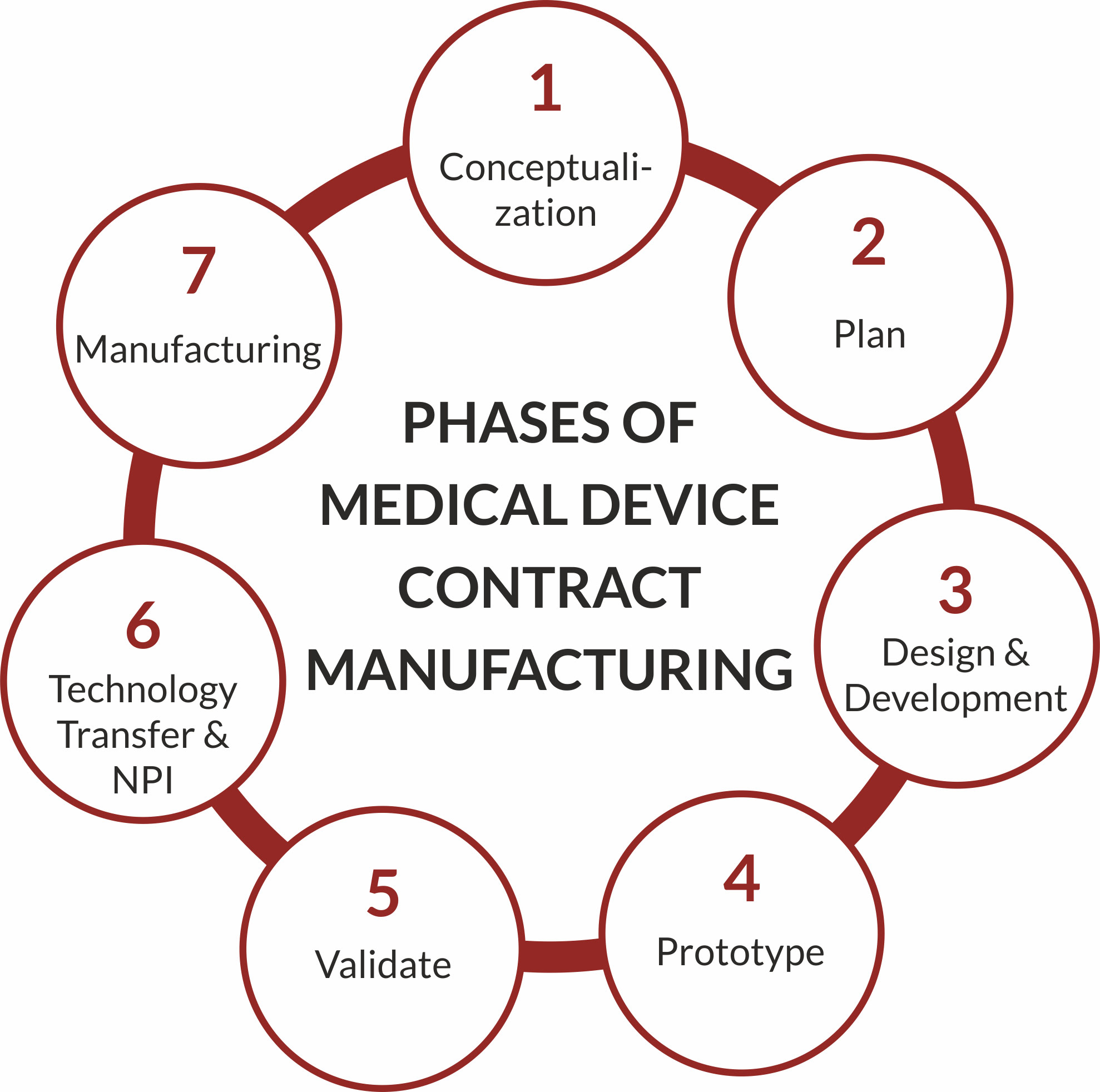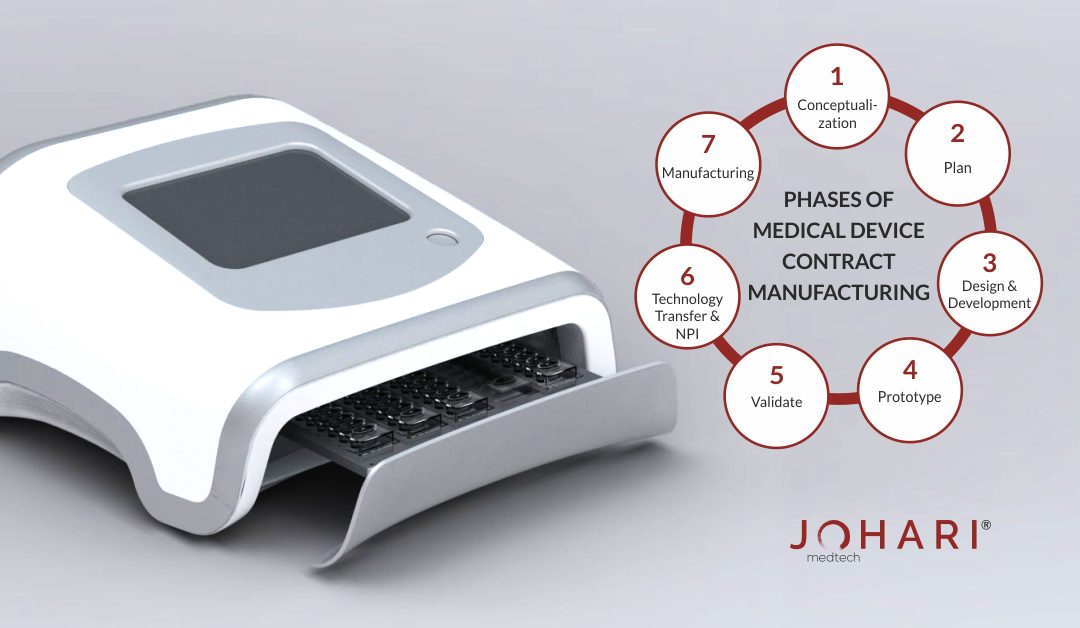An idea might seem revolutionary in theory but when put to real test in terms of an end product without adequate research it might not live up to the expectations of the end user. It’s necessary to analyze end-user requirements and technology acceptance rate before rushing to the next stage.
Medical Device Contract Manufacturing requires a multidimensional approach. A novel Medical Device idea must withstand different requirements of quality, sturdiness, specific local regulations and safety.
Here we discuss 7 phases of the Medical Device Manufacturing Cycle that are important for manufacturing medical devices:

1. Conceptualization
The primary stage of conceptualization involves evaluating the idea on multiple grounds to understand its worth and market position. The process involves user feasibility testing, cost structuring, competitive analysis, and scalability test. One should also keep the geography-specific regulations in mind before finalizing the concept so that the final product is easy to market.
2. Planning
Now that you have finalized the concept, you are ready to pen down the strategy for raw material requirements, potential vendors and overall production cost. Also, it would be an intelligent move to pre-plan for supply chain and logistics to avoid delay in time to market.
3. Design & Development
Once you are ready with your preliminary requirements, you can proceed with the design of the product. The primary motive of the design phase is to give shape to the initial rough idea. The design phase covers Industrial Design, Mechanical Design, Software Design, Electrical Design, and Electronics design. Each part of the designing process has a specific purpose. The industrial design involves testing the feasibility of the device for the intended use. Mechanical Design involves testing the aesthetics and handling aspects of the device. Software design involves incorporating the intuitive UI/UX for easy operation. The PCB designing and electrical designing involve making the functionality efficient.
The device must meet the requirements of operation, usability and cost. Engineers and designers should not make the device too complex for a new user, it should offer ease of use and smooth handling. Lastly, but most importantly designers must keep track of the component status. The designer should plan well for component obsolescence and NRND (Not recommended for New
Designs). Incorporating an obsolete/NRND component in the device might complicate procurement task or make it too costly.
4. Prototyping
The prototyping stage involves multiple iterations of the design to account for the feasibility, scalability and effectiveness of the design created. It’s important to test the product efficiency for user feasibility and cost. The size and shape of the product determines the handling ease and user delight. Prototyping plays a crucial role in determining the scalability and efficiency of the design. Once the prototype is ready it can be sent for validation.
5. Validation
In the validation phase of the product life cycle the device design is validated for safety and effectiveness. The clinical evaluations of the device determines whether the product can be moved to the next stage. The clinical evaluation involves checking the device for its intended use and impact. Any risks associated with the device are checked, minimized and reduced to transfer the best iteration of the product for manufacturing. Once the design is validated on multiple parameters, it is transferred for regulatory submissions.
6. Technology Transfer & NPI
The technology transfer refers to the stage when all the knowledge about the conceptualized design is transferred to the mass manufacturing stage. Before transferring the design for mass manufacturing each of the device specific processes is validated and verified. The NPI validation involves checking the capabilities, machines and production line efficiency.
7. Manufacturing
Once everything is in place, the approved prototype is transferred for mass manufacturing. Many big Medical Device companies are outsourcing the manufacturing of their medical devices. It’s important for them to choose the right contract manufacturer who delivers as per their needs.
One should evaluate the capabilities, regulatory compliance of the processes and Quality Management System of the manufacturer to ensure fast paced, quality and regulatory compliant manufacturing of the product.
Conclusion:
Finally, when the product is ready to be launched manufacturers and marketers must be ready to receive and record feedback. Once a detailed analysis of the product feedback has been done necessary changes can be recommended and implemented.
Post Market Services involve providing service in case of any breakdown or fault at the user’s end. Any adversities reported are kept in record and traced back. Once the root cause is identified, the follow up studies are done to rectify the causes and make improvements.
As a globally acclaimed Medical Device Contract Manufacturer, Johari caters to its global clients from a 65,000 square foot, state of the art medical device manufacturing facility in India along with an R&D Center in Europe. Johari’s versatile product development and manufacturing portfolio includes innovative life science products, diagnostic devices, and therapeutic devices. The company provides Contract Manufacturing solutions to global MedTech giants as well as innovative start-ups. The facility is equipped with advanced capabilities to manufacture complex to high-volume products.

